Coax Cable Connectors: TNC, F, FME & TV Types Explained
Aug 3,2025
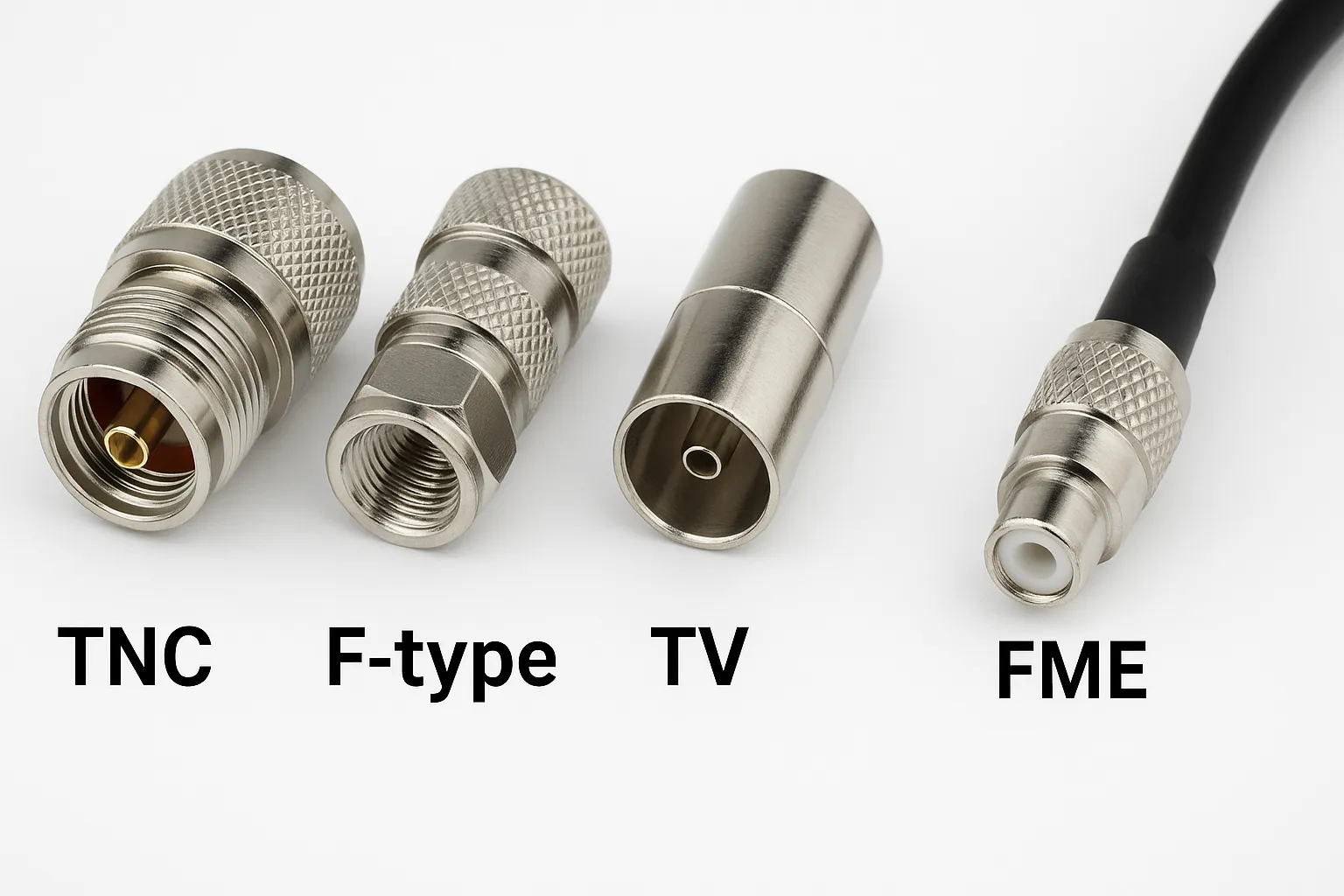
This image illustrates the visual and structural differences between four popular RF connector types: TNC with threaded coupling, F-type with threaded barrel, TV (IEC) with push-fit, and FME for miniature applications.
Coaxial cable connectors are essential components in RF (radio frequency) systems, allowing secure, low-loss connections between cables and equipment. There are many coax cable connectors types designed for different applications and frequencies. In this comprehensive guide, we focus on four common connector types – TNC connector, F connector, FME connector, and TV connector (IEC type) – explaining their features, uses, and differences. This overview will also address frequently asked questions about these connectors, such as “What is a TNC connector?”, “What is the difference between BNC and TNC?”, and more.
Introduction to RF Coaxial Connectors
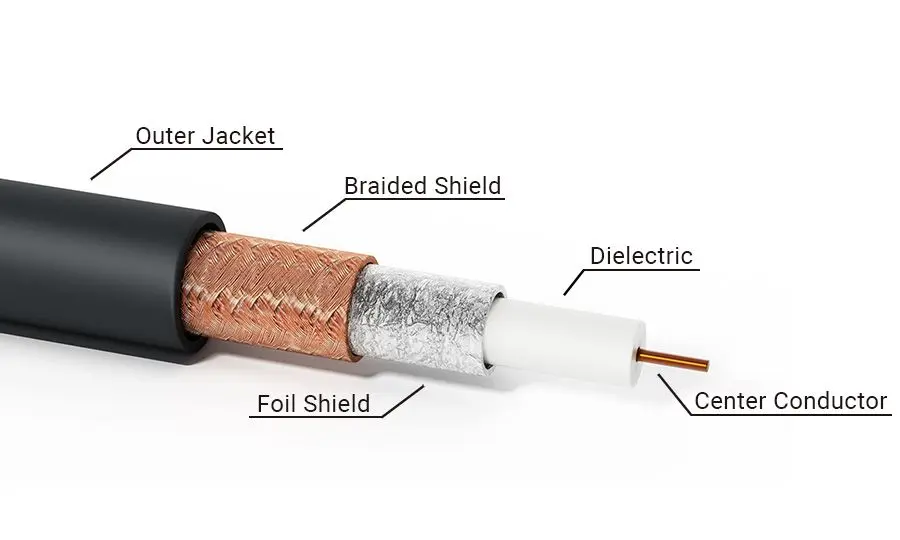
This image provides a cross-sectional view of a coaxial cable, detailing each layer—central conductor, dielectric insulator, metallic shield, and outer jacket—used to preserve signal integrity and minimize interference.
Coaxial connectors are specialized fittings that attach to the ends of coaxial cables, maintaining the cable’s shielding and impedance. They ensure a stable connection for high-frequency signals used in communications, broadcasting, and networking. Many connector styles exist (e.g., BNC, SMA, N-type, etc.), each suited to particular frequency ranges and industries. In this article, we will highlight four popular coax connectors that represent different use-cases:
- TNC connectors – Threaded medium-size connectors (50 Ω) often used in radio communication and Wi-Fi equipment.
- F connectors – Threaded F-type connectors (75 Ω) commonly used for cable TV, satellite TV, and cable modems.
- FME connectors – Small threaded connectors (50 Ω) used primarily for mobile and vehicular antenna installations.
- TV connectors – Push-in connectors (approximately 75 Ω) used for over-the-air TV antenna hookups (also known as PAL or IEC connectors).
Each of these connector types has unique characteristics. Below, we’ll examine the different types of coaxial cable connectors in detail, followed by a handy comparison table and an FAQ section to answer common questions.
Which Types of Coaxial Cable Connectors Are Available?
When it comes to RF applications, there is a wide variety of coaxial connectors available. Let’s focus on four major types by exploring their design, impedance, typical frequency range, and common uses.
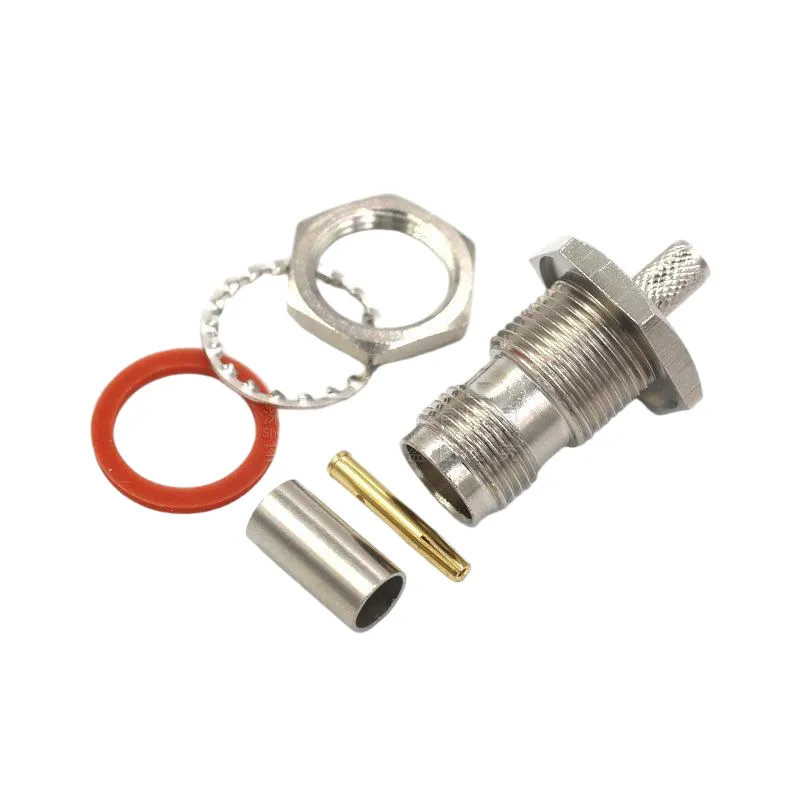
This close-up photo highlights the external threading and metallic housing of a TNC connector, which is often used in rugged RF environments.
- TNC Connectors – TNC connectors are medium-sized, threaded coaxial connectors that provide a secure connection with excellent performance at higher frequencies. They are a threaded variant of the BNC connector, maintaining a 50 Ω impedance. The threaded coupling prevents accidental disconnection and offers improved vibration resistance compared to BNC’s bayonet lock. TNC connectors can operate up to ~11 GHz, making them suitable for many RF applications that BNC connectors (typically reliable up to ~4 GHz) might not cover. What is a TNC connector used for? They are commonly found in radio communication equipment, antenna connections, and Wi-Fi devices (for outdoor antennas, often in their reverse-polarity form). Standard TNC plugs have a male center pin and internal threads in the coupling nut, while TNC jacks have a female receptacle and external threads on the barrel. TNC connectors come in both standard and reverse polarity (RP-TNC) versions – the latter swaps the gender of the center pin to comply with certain wireless equipment regulations (often seen on Wi-Fi routers).
- Design: Threaded coupling interface (7/16-28 UNEF thread). Similar size as BNC, but with screw-on attachment instead of quick bayonet. This design ensures a firm connection that won’t loosen with vibration. Difference between BNC and TNC: Unlike the quarter-turn twist lock of BNC connectors, TNC connectors must be fully threaded on, which takes a bit longer to connect but supports higher frequencies and is more secure in motion.
- Impedance: 50 Ω characteristic impedance (a 75 Ω variant of TNC also exists for certain video applications, but it is less common).
- Frequency Range: Typically usable from DC (0 Hz) up to about 11 GHz. Standard TNC connectors perform well into the microwave range, which is why they are favored over BNC for some higher-frequency uses.
- Applications: Used in military and commercial radio systems, RF modules, wireless infrastructure, and test equipment. For example, many antenna cable connectors on devices like GPS units or older cellular antennas use TNC connectors. TNC is also found in instrumentation and radar connections where a mid-size, robust connector is needed.
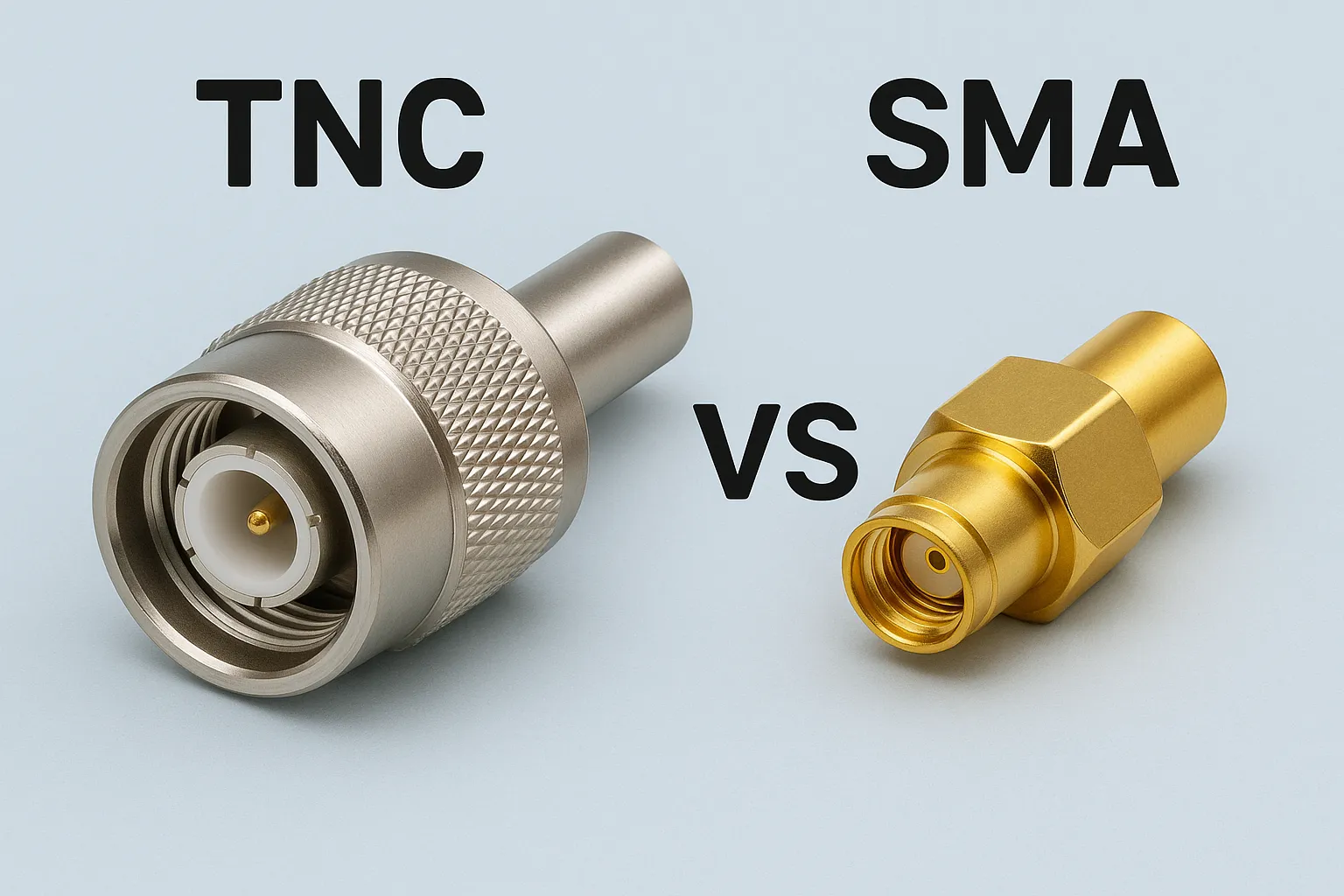
This comparison shows that TNC connectors use threaded coupling and support rugged environments, while SMA connectors are smaller and ideal for high-frequency microwave applications.
Comparisons: TNC vs SMA – TNC and SMA connectors are both threaded 50 Ω connectors, but TNC is larger and not compatible with SMA. SMA connectors are much smaller and rated for even higher frequencies (~18 GHz or more), whereas TNC is mid-sized. They each have different thread sizes, so you cannot mate a TNC to an SMA without an adapter. TNC vs N-type – TNC connectors are smaller than N-type connectors. An N-type connector is a large, high-power threaded connector (50 Ω) often used on base station antennas; it is not the same as TNC. If you see a question like “Is TNC the same as N-type?” – the answer is no, they are different in size and thread (N-type uses a 5/8-24 thread and is designed for higher power handling). However, adapters are available to interconnect TNC and N-type when needed.
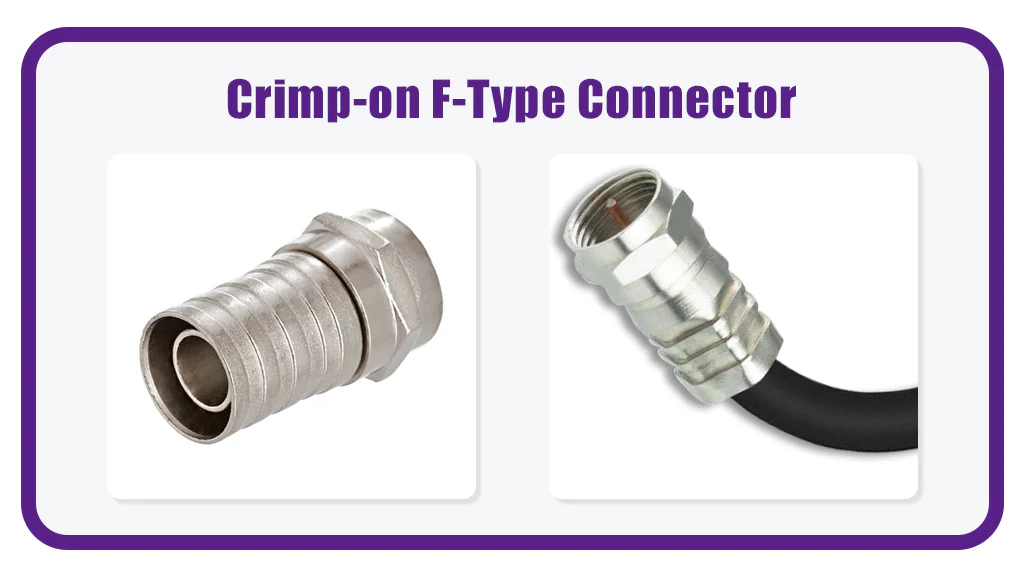
The image highlights the structure of an F-type connector, featuring a screw-on design that ensures secure signal transmission in consumer-grade TV and broadband installations.
- F-Type Connectors – F connectors (also known as F-type connectors) are widely recognized from their use in cable television and satellite TV setups. They have a 75 Ω impedance and are designed primarily for frequencies up to about 1 GHz (over-the-air TV) but can handle up to ~2.4 GHz for satellite and broadband cable. The F connector’s design is unique in that the center conductor of the coaxial cable itself serves as the center pin of the male connector. The male F-type plug screws onto the cable’s stripped end (capturing the cable’s braided shield under a crimped or threaded sleeve), and its threaded nut (3/8-32 thread) then screws onto a female port. What is an F connector used for? You’ll find F connectors on TVs, cable modems, satellite receivers, DVRs, and coaxial wall outlets. In North America, the cable TV port on the back of your TV or modem – often simply called the “coax input” – is a female F connector.
- Design: Threaded male plug and female jack. The male has an internal threaded nut and uses the cable’s solid copper core as the mating pin, while the female F connector (on equipment or wall plates) has external threads and a center socket. This simple design makes F connectors inexpensive and easy to install with basic tools. However, it also means the connection relies on the cable’s stiffness and might not be as durable with repeated reconnections compared to other connector types.
- Installation: Attaching an F connector typically involves stripping the coax cable (usually RG-6 or RG-59) and either twisting on a connector or compressing/crimping a connector with a special F connector tool. Compression connectors are commonly used by cable installers for a more secure, weather-tight fit.
- Impedance & Performance: 75 Ω impedance, well-suited for domestic TV frequencies (VHF/UHF) and intermediate frequencies used in satellite feeds. F connectors maintain a good impedance match through the GHz range. They have usable bandwidth into the gigahertz (sufficient for satellite TV, which often uses up to 2 GHz).
- Applications: Primarily used in domestic television distribution – connecting TVs to aerial antennas, cable TV networks, and satellite dishes. Also used for cable internet (cable modems). In these systems, cost and ease of use are important; F connectors excel in both. They are not typically used in professional radio-frequency test equipment (where precision connectors like BNC or N are preferred), but you will see them in every household cable setup.
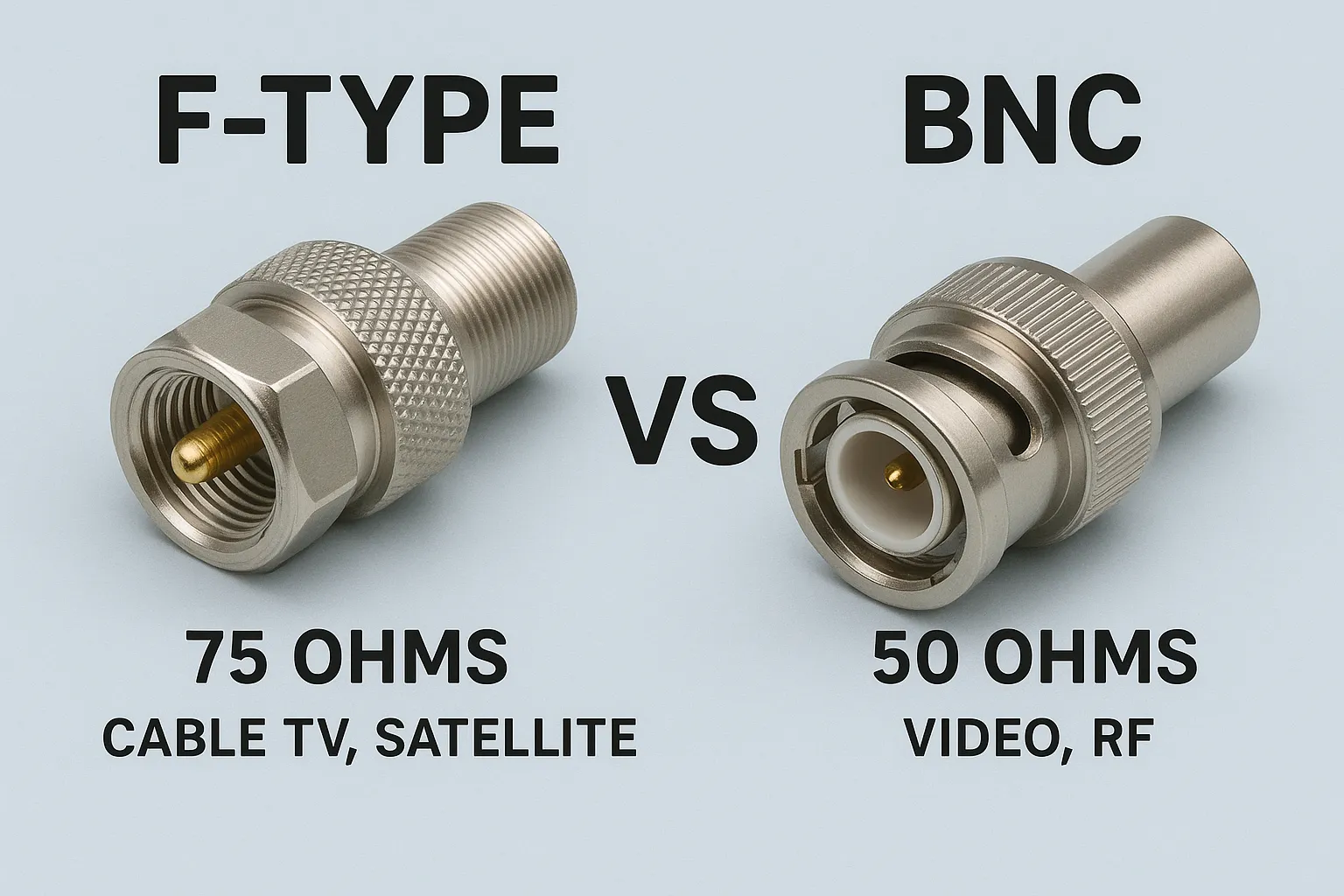
This comparison demonstrates the BNC connector's bayonet locking mechanism versus the F connector's threaded coupling, suited for different use scenarios.
- Comparisons: Coaxial vs F connector – Sometimes people ask, “What’s the difference between a coaxial connector and an F connector?” In fact, an F connector is a type of coaxial connector. “Coaxial connector” is a broad term for any connector used with coax cable, while the F-type connector specifically refers to this common threaded connector for TV coax. BNC vs F connector – BNC connectors are 50 Ω or 75 Ω bayonet-lock connectors often used in professional settings (broadcast, test gear), whereas F connectors are 75 Ω and use a screw-on coupling primarily for consumer TV use. BNC has a dedicated center pin and locking lugs, making it quick to connect and disconnect; F connectors are cheaper and use the cable’s wire as the pin, but require screwing on/off. The two are not interchangeable without an adapter (however, adapters exist, for example to connect an F connector cable to a BNC input).
- F-Type Plug: The term “F-type plug” refers to the male F connector that attaches to a cable. It is called a plug because it plugs into the equipment’s female jack. In summary, if someone asks “What is an F-type plug?” – it’s simply the male end of an F connector cable, the piece at the tip of a TV coax cable that you screw onto your TV or cable box.
- Joining Coax Cables: If you need to connect two coaxial cables with F connectors, you would use an F connector joiner – this is a small double-female coupler (often called an F-81 barrel connector). This is generally the best way to join a coaxial cable without installing a new longer cable: each cable’s male F plug screws into either end of the barrel to extend the run. It’s much better to use these dedicated couplers or install new connectors than to attempt splicing coax cables directly, which can cause signal loss.
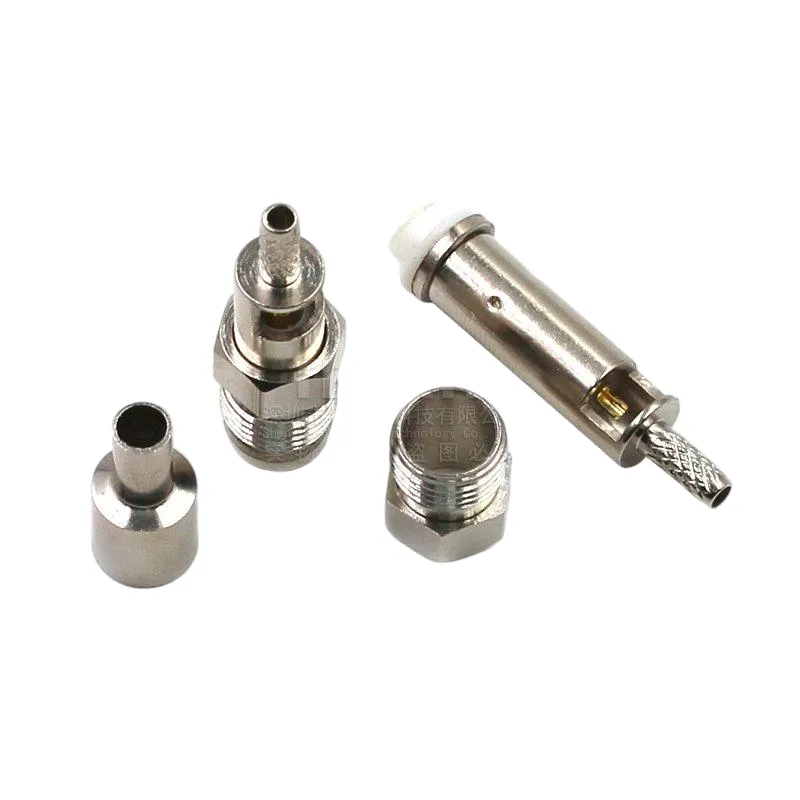
An angled image of an FME connector used for RF systems requiring miniature and flexible cable routing, often applied in mobile communication hardware.
- FME Connectors – The FME connector (which stands for “For Mobile Equipment”) is a small, threaded coax connector designed for applications where cable routing space is tight. It is a 50 Ω impedance connector, typically used from DC up to around 2 GHz. What is an FME connector used for? It’s primarily found in vehicle communication systems and mobile antennas – for instance, connecting an in-car CB or cellular antenna cable through a vehicle’s chassis. The defining feature of the FME connector is its miniature size and low-profile design. An FME female connector, once crimped or soldered onto a cable (like RG-58 or LMR-195), has a slim outer profile, allowing it to be easily fed through narrow holes or tight spaces. Once the cable is in place, an adapter (FME male to whatever connector is needed) can be attached to interface with devices.
- Design: Threaded coupling with metric M8 x 0.75 threads. The FME female is usually the cable end connector, featuring a small threaded outer shell and a female socket for the center conductor. The FME male is often not a permanent cable connector but rather an adapter that screws onto the female to convert it to another interface (like FME male to SMA male, FME male to PL-259, etc.). There are also FME male cable connectors available for extensions or special cases, but typically in mobile installations the cable is terminated with an FME female, then adapted as needed.
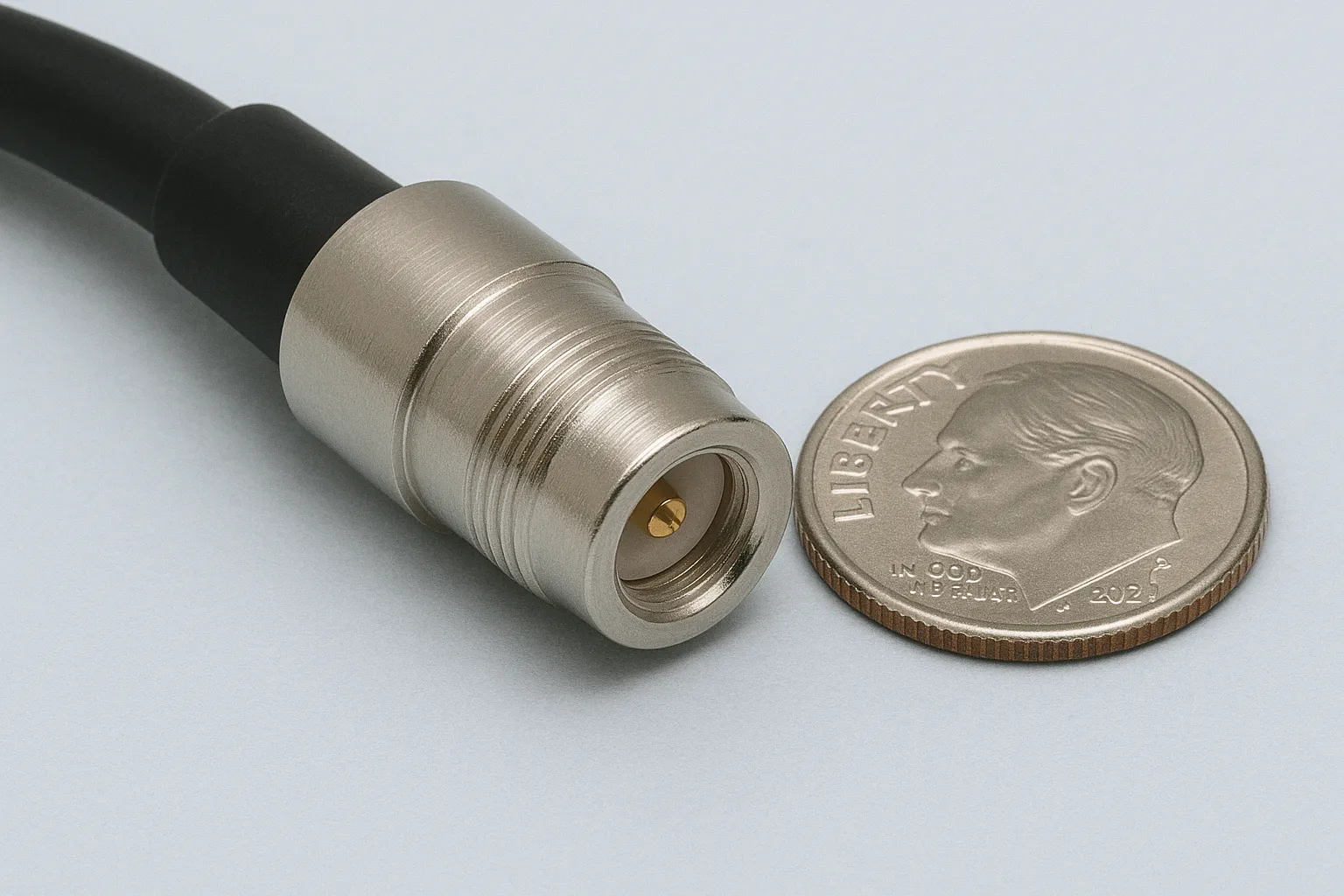
This image places a standard FME female connector beside a coin (e.g., US dime or 1 yuan) to visually represent its miniature form factor, making it ideal for space-limited RF applications.
- Size: FME connectors are very compact. The outer thread diameter is 8 mm, with a fine 0.75 mm thread pitch. The connector’s small size is precisely to let it pass through small openings – for example, a car’s firewall or the deck of a boat – where larger connectors like TNC or N would not fit. If someone asks “What size is the FME connector?”, they may be inquiring about this physical thread size or the general small form factor. In short: it’s one of the smallest RF connectors, about 6 mm across the threaded part, making it ideal for tight installations.
- Performance: 50 Ω impedance, typically usable up to 2 GHz with low loss. (Some sources note standard FME is rated up to ~200 MHz in certain specs, but in practice quality FME connectors and adapters can work for cellular frequencies around 900 MHz and even up to 2.4 GHz in some cases). They are not intended for extremely high frequency or high power, but are excellent in the VHF, UHF, and low microwave range for mobile applications.
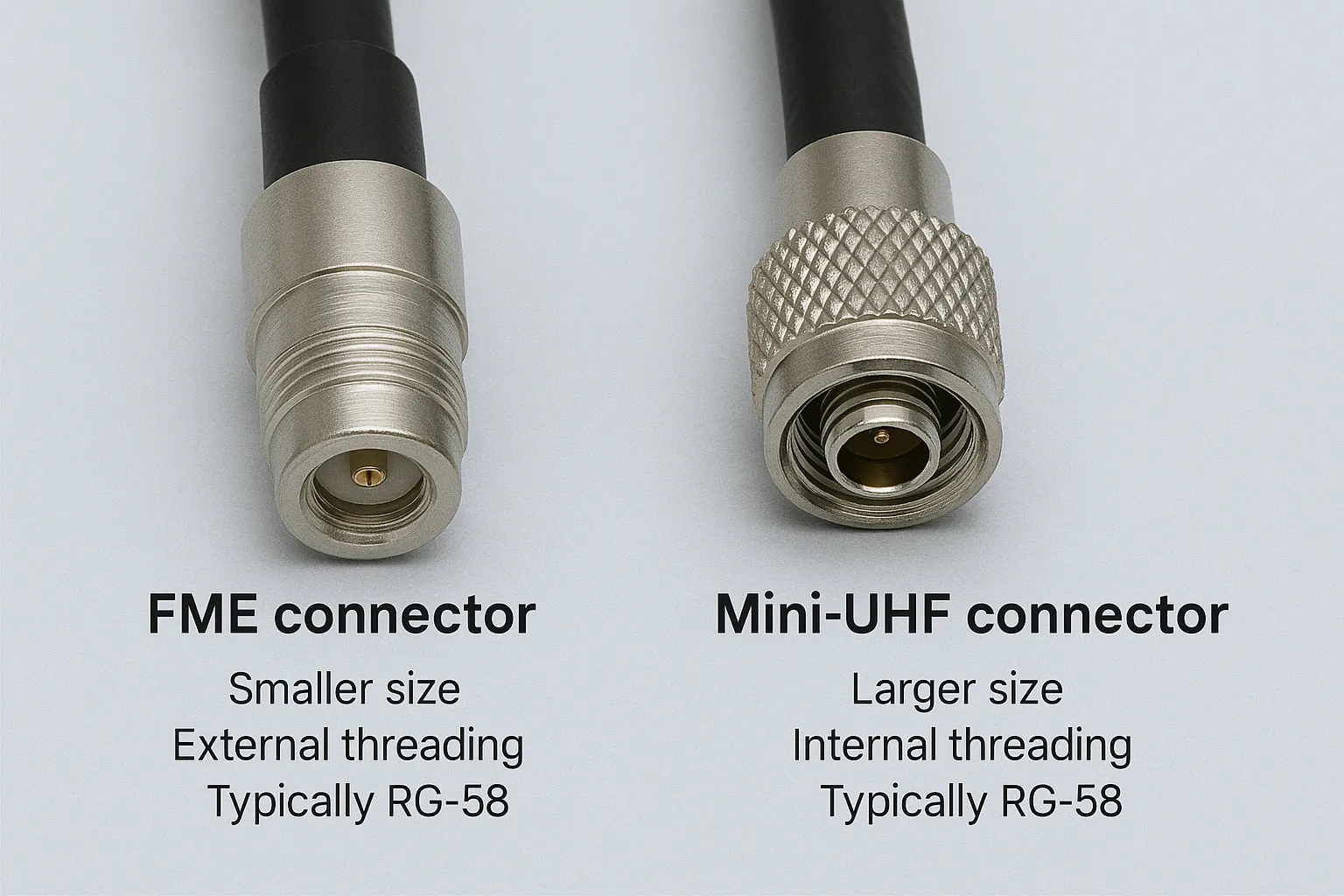
The FME and Mini UHF connectors are shown side-by-side to reveal distinctions in threading design and usage. FME is optimized for tight space, while Mini UHF supports slightly higher RF handling.
- Applications: Commonly used in vehicular antenna kits, such as those for car mobile two-way radios, cellular signal boosters, and marine antennas. For example, a cellular booster cable might have an FME female end inside the vehicle; you then screw on an appropriate adapter to connect to the booster unit (which might use an SMA or TNC connector). This modular approach makes it easy to run cables and then choose the right adapter for the equipment. FME vs Mini-UHF: Both FME and mini-UHF connectors are used in mobile scenarios. The mini UHF connector is another small 50 Ω connector (with a threaded coupling similar to a scaled-down UHF/PL-259). Mini-UHF connectors were common on older car phones and some radio equipment. Comparing the two, FME connectors are smaller and slimmer than mini-UHF. Mini-UHF has a slightly larger diameter and isn’t as easy to feed through tiny holes as FME. Additionally, mini-UHF connectors have a coarse thread interface and typically are rated up to about 2.5 GHz; FME’s advantage is mainly its slim profile and the ability to easily adapt.
- Comparisons: N vs FME – An N-type connector is much larger than an FME and can handle more power. You’d see N connectors on base station antennas or bulkhead mounts, and FME on the thin cable running to it inside a vehicle. They are not interchangeable; if you need to connect an FME-terminated cable to an N connector, you use an adapter. The question “What is the difference between N and FME connectors?” comes up often: essentially, N connectors are for heavy-duty, high-frequency use on larger cables, whereas FME connectors are for lightweight, mobile use on small cables. Both are threaded and 50 Ω, but they serve different purposes.
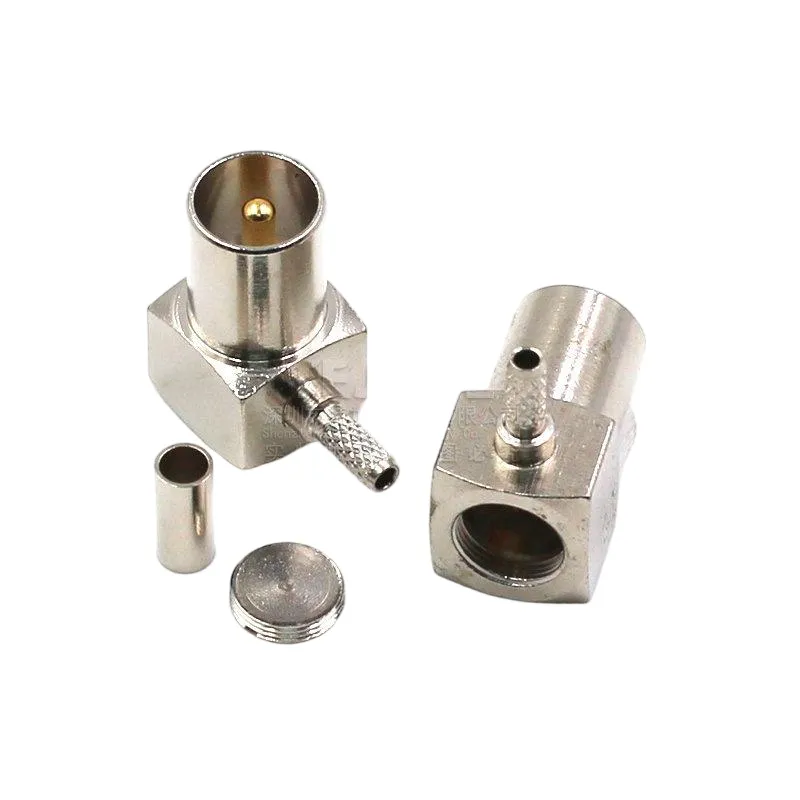
This graphic summarizes different forms of TV connectors, including IEC push-in, F-type threaded, and right-angle designs used in global markets.
- TV Coax Connectors (IEC/PAL) – When we refer to TV connectors in this context, we mean the traditional push-in antenna connectors commonly used on TV sets, especially in Europe, Australia, and parts of Asia. These are also known as PAL connectors, Belling-Lee connectors, or simply IEC 61169-2 coax connectors. They are the familiar plugs that connect an antenna cable to the back of a television for over-the-air broadcast signals. A standard TV aerial connector consists of a male plug (usually on the cable from the antenna or wall outlet) and a female jack (on the TV). What is the TV antenna connector called? Often just “TV aerial plug” or “antenna plug.” In Europe, if you buy a TV or an aerial cable, it likely uses this IEC type connector. In North America, these are less common because F connectors serve the same purpose on TVs; however, older VHF/UHF antenna inputs on some equipment in the US used a 75 Ω push-on connector or required an adapter (remember the old screw terminals and baluns). Modern US TVs simply use F connectors for antenna/cable input, so “TV connector” as a term can vary by region.
- Design: Push-in friction fit – The male TV connector is a smooth cylindrical plug (approximately 9.5 mm outer diameter) with a center male pin. The female connector on the TV or wall plate is a corresponding 9.5 mm receptacle with a female socket inside. There is no threaded or locking mechanism; it simply pushes in and can be pulled out. This makes it convenient for indoor setups where the connection isn’t stressed by movement. However, it’s not very secure for environments with vibration or if the cable is tugged.
- Impedance & Performance: Typically around 75 Ω (since it’s used for TV signals). It works well for frequencies in the VHF and UHF TV broadcast bands (say, up to 1 GHz or so). It is not designed for higher microwave frequencies or very low-loss connections, but for the purpose of receiving TV signals, it’s adequate. The simplicity of the design means it’s also not weatherproof – outdoor antenna installations often have the cable terminate in an F connector or a weather-sealed connection, which then might adapt to an indoor TV connector.
- Applications: Used for terrestrial TV antennas and radio antennas (FM radio receivers sometimes use a similar connector). If you’re setting up an indoor TV antenna (rabbit ears) or connecting a TV to a wall antenna socket in, say, Germany or Australia, you’re likely dealing with these IEC/PAL connectors. They are also found on some radio/TV equipment like VCRs, FM tuners, etc.
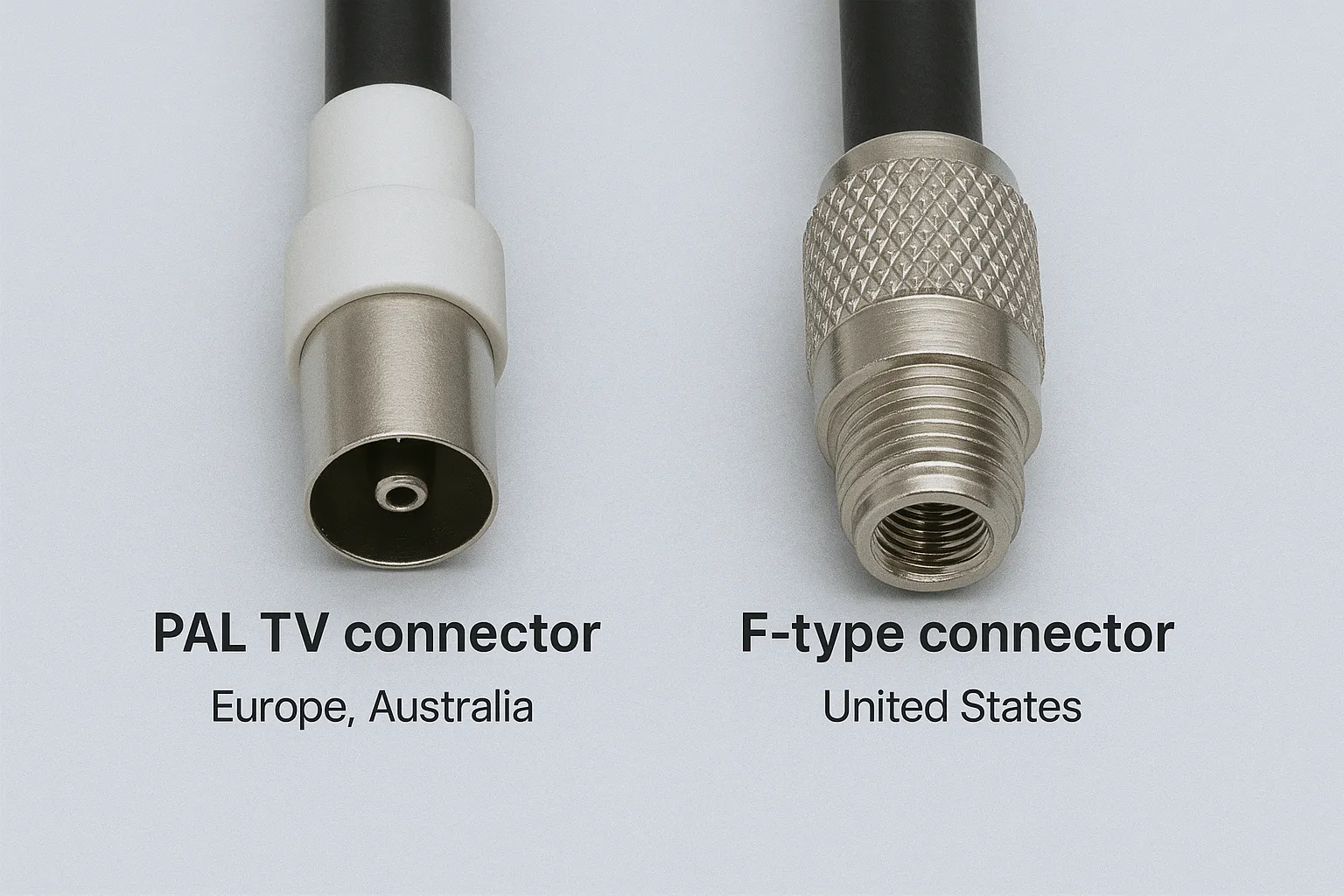
This photo illustrates the key structural difference between an IEC TV connector and a threaded F connector, highlighting push-fit vs screw-on use cases.
- F Connector vs TV Connector: Many people encounter both an F connector and a TV aerial connector and wonder why they are different. F connectors are common in cable/satellite systems and in North America, requiring screwing on. IEC TV connectors are common in broadcast TV antennas and in Europe/Australia, and simply push on. Adapters exist to convert one to the other (for instance, an F to PAL adapter) when needed.
- Using the TV Connector: If you ask “How do I connect my TV connector to my TV?”, the answer is straightforward: take the male plug at the end of your antenna cable and firmly push it into the female TV antenna input on your television. If the cable uses an F-type plug (common in the US), then you would instead align the connector and twist the nut clockwise to thread it onto the TV’s F-type jack. Essentially, “TV connector” in everyday language refers to whatever connector your TV expects for an antenna/cable input.
- Cable TV Ports: On cable TV or satellite equipment, the port you connect to is typically an F connector jack. Some call it the “cable TV port”, but the technical name is an F connector. On TVs or set-top boxes in regions using IEC connectors, the port might simply be labeled “ANT IN” or “Antenna” and is a push-in IEC jack. So if someone wonders “What is a cable TV port called?” – you can answer: it’s usually an F connector in most modern systems, or an IEC antenna connector in some cases, used to join the coaxial cable feed to your TV or tuner.
Internal Link: For a wide selection of RF coaxial connectors including TNC, F, FME, and TV connectors, feel free to explore our product catalog of RF connectors. You’ll find detailed specifications and variants for each connector type.
Comparison Table of Connector Types
To summarize the key features of the connector types discussed, see the table below. It compares their impedance, frequency range, coupling mechanism, and common usage at a glance:
| Connector Type | Impedance (approx.) | Frequency Range | Coupling Mechanism | Common Applications |
|---|---|---|---|---|
| TNC Connector | 50 Ω (standard) 75 Ω variant avail. |
DC – 11 GHz (microwave) | Threaded screw-on (7/16-28 UNEF) | Radio comms, antenna cable connectors (Wi-Fi, radar), moderate-power equipment |
| F-Type Connector | 75 Ω | 0 – 2.5 GHz (TV, satellite) | Threaded screw-on (uses cable’s core as pin; 3/8-32 thread) | Cable TV, satellite TV, cable internet modems, VCR/TV connections (NA market) |
| FME Connector | 50 Ω | DC – 2 GHz (usable up to ~2.4 GHz) | Threaded screw-on (miniature M8 × 0.75) | Mobile and vehicular antenna leads, signal boosters, marine radios |
| TV Connector (IEC/PAL) | ~75 Ω | 0 – 1 GHz (TV broadcast) | Push-in friction fit (9.5 mm plug) | Terrestrial TV antenna cables, radio receivers (EU/AUS markets), indoor TV feeds |
Note: All the above are coaxial connectors for RF signals. Other popular coax connectors include BNC (50 Ω/75 Ω), SMA (50 Ω), N-type (50 Ω), UHF/PL-259 (~50 Ω), and many more, each with its own specific use cases. In this article, we focused on TNC, F, FME, and IEC TV connectors due to their broad relevance in consumer and commercial RF applications.
Frequently Asked Questions (FAQ) about Connectors
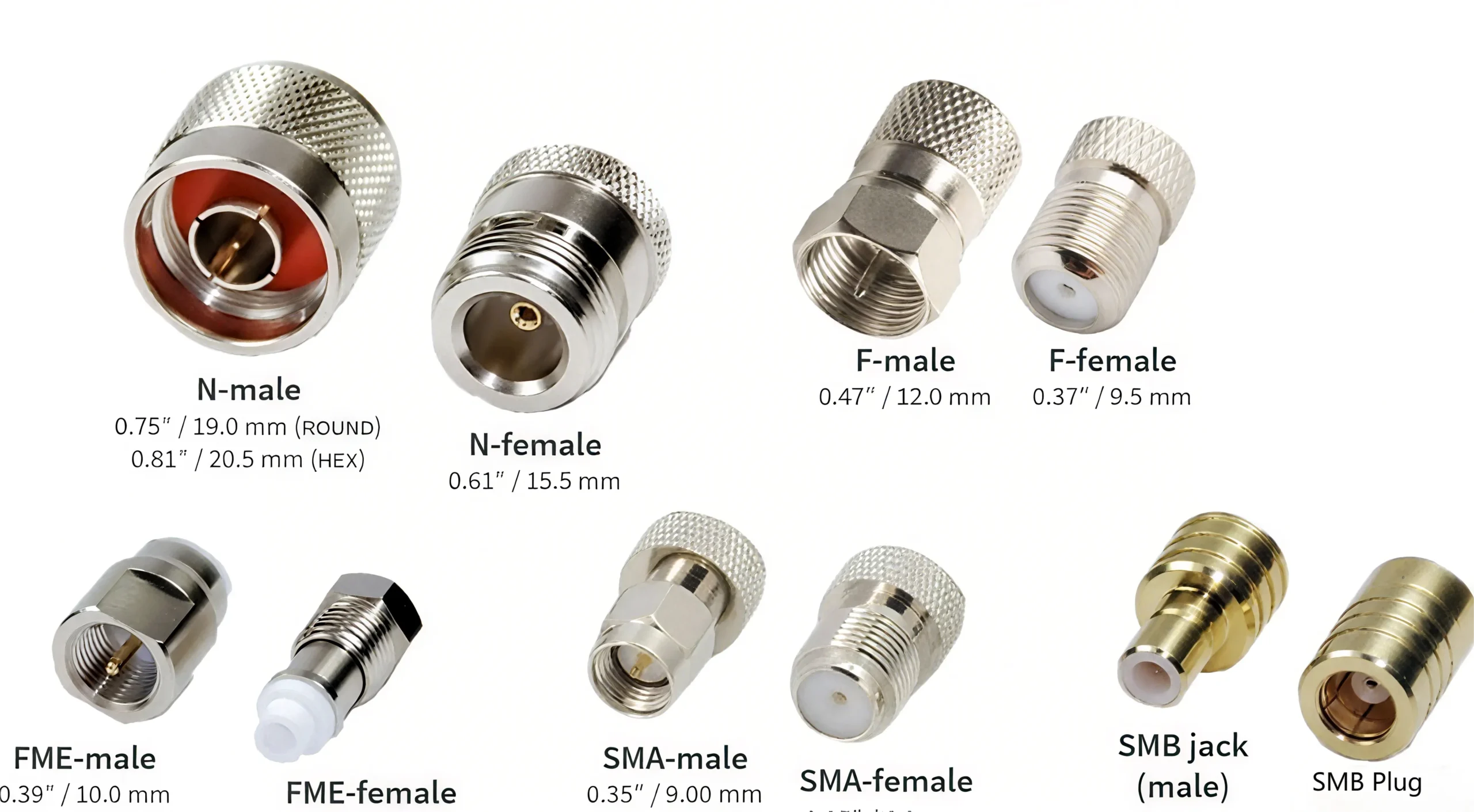
An overview image comparing N-type for high power, FME for compact routing, SMA for microwave, and SMB for quick connections in RF networks.
Q1: What is a TNC connector?
A1: A TNC connector is a threaded RF coaxial connector with 50 Ω impedance. TNC stands for Threaded Neill–Concelman, named after its inventors. It’s essentially a screw-on version of the BNC connector, supporting higher frequencies (up to ~11 GHz) and offering a more secure connection for applications like antennas and communications equipment. In practice, a TNC connector is the round screw-on connector you might see on devices like some Wi-Fi access points, radios, or GPS units.
Q2: What is the difference between BNC and TNC connectors?
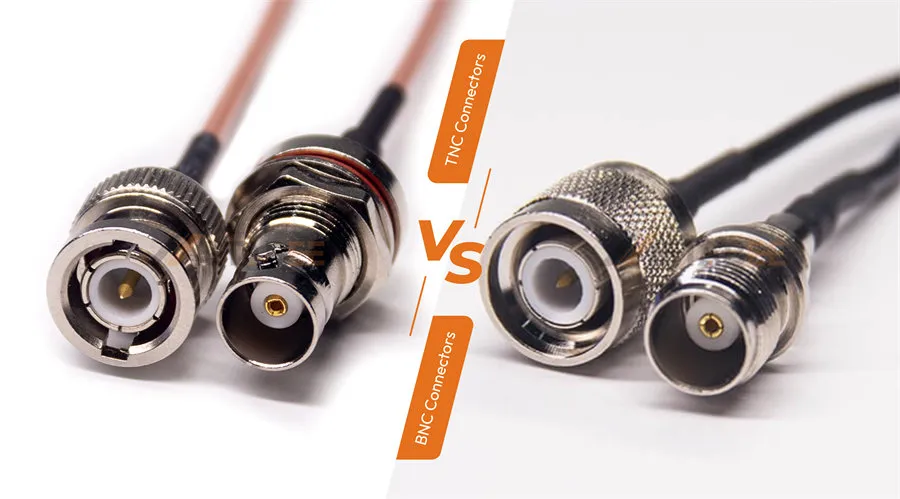
BNC uses bayonet-style connection for quick release; TNC offers threaded design for better environmental sealing and durability.
A2: The main difference is the coupling mechanism and frequency performance. BNC connectors use a bayonet twist-lock design (you insert and twist 1/4 turn to lock) and are quick to connect, typically reliable up to about 4 GHz (for 50 Ω versions). TNC connectors use a threaded screw-on coupling, which takes a bit longer to connect but provides a more stable connection that can perform up to ~11 GHz. TNC’s threaded design handles vibration better than BNC. Both have similar size and both usually have 50 Ω impedance (75 Ω BNC exists for video, and 75 Ω TNC also exists but is rare). They are not intermateable with each other (you cannot plug a TNC into a BNC without an adapter).
Q3: Is TNC the same as SMA?
A3: No, TNC and SMA are different connector types. SMA connectors are much smaller than TNC connectors and have a different thread size. SMA is a 50 Ω connector commonly used up to 18 GHz or higher, often on handheld radio devices, antennas, and microwave equipment. TNC connectors are larger, also 50 Ω, and max out around 11 GHz. You cannot mate a TNC directly with an SMA – their threads do not match and their size is different. Adapters exist if you need to go from SMA to TNC or vice versa, but otherwise they are separate standards.
Q4: Is TNC the same as N-type?
A4: No, a TNC connector is not the same as an N-type connector. N-type connectors are physically much larger and are designed for higher power and lower loss at microwave frequencies. N-type uses a different thread (5/8-24) and can handle more rugged outdoor use (often weatherproof). TNC is a medium-sized connector (thread 7/16-28) more common on smaller devices and cables. They both are 50 Ω threaded connectors, but you cannot connect a TNC to an N-type directly. Again, adapters can connect between them if needed.
Q5: What is an F connector used for?
A5: An F connector is used for television and video signal coaxial cables. Its primary use is to connect coaxial cables in cable television (CATV), satellite TV systems, and cable internet setups. For example, the connector on the end of the cable that screws onto your cable box, TV antenna input, or cable modem is usually an F connector. They are popular in home installations because they are cheap, easy to install, and work well at VHF/UHF and satellite intermediate frequencies.
Q6: What is the difference between coaxial and F connectors?
A6: The term “coaxial connector” refers to any connector designed for coaxial cable – it’s a broad category. F connectors are one specific type of coaxial connector (one of many). If someone contrasts them, they might be thinking of the old-style TV antenna plugs (IEC coax plugs) versus the F-type, or just misunderstanding terms. In summary: an F connector is a kind of coaxial connector mainly for TV signals. Coaxial connectors also include BNC, TNC, SMA, etc. So all F connectors are coax connectors, but not all coax connectors are F connectors.
Q7: What is the difference between BNC and F connectors?
A7: BNC connectors and F connectors both attach to coaxial cables but are quite different in design and typical use. BNC connectors (Bayonet Neill–Concelman) use a twist-lock mechanism and usually 50 Ω impedance (with some 75 Ω versions for video). They are common in professional settings – like test equipment, security cameras, and broadcast. F connectors use a screw-on mechanism (the cable’s core is the center pin) and are 75 Ω, common in consumer TV/cable. BNC connectors are generally reusable and of sturdier build, whereas F connectors are often one-time installations (crimped or threaded onto a cable). If you need to connect a cable with a BNC to a device with an F connector, you’d use a BNC-to-F adapter.
Q8: What is an F-type plug?
A8: An F-type plug is simply the male F connector attached to a coax cable. It’s the piece at the end of a TV coax cable that has threads on the inside and a tiny copper wire sticking out – that wire is the center conductor of the cable acting as the plug’s pin. This F-type plug screws onto an F-type jack (female) on your TV or other device. In short, “F-type plug” = male F connector on a cable.
Q9: What is an FME connector used for?
A9: An FME connector is used for mobile and vehicular antenna connections. It’s a small 50 Ω coax connector often found on cables for car-mounted antennas (CB radio, cellular boosters, taxi radio systems, etc.). The FME’s slim profile lets you run the antenna cable through tight spaces (like a car’s body panels). Once inside the vehicle, the FME connector typically screws into an adapter that converts it to whatever connector the radio or device requires (such as converting FME to an SMA or PL-259 connector). This way, you can install antennas on vehicles without drilling large holes – a small hole for the cable is enough, thanks to the tiny FME connector.
Q10: What size is the FME connector?
A10: The FME connector has an outer thread diameter of about 8 mm with a 0.75 mm thread pitch. In practical terms, it’s roughly 6 to 7 mm across the outer sleeve – quite small compared to most other RF connectors. This compact size is a key feature of FME connectors, enabling them to pass through narrow openings. Internally, the center pin of an FME is around 1.2 mm in diameter. So if by “what size” we mean how physically large: it’s one of the smallest RF connectors, much smaller than, say, a TNC or N connector.
Q11: What is the difference between N and FME connectors?
A11: N connectors and FME connectors differ in size, power handling, and usage. N connectors are large, robust connectors used in high-power and microwave frequency applications (e.g., radio transmitters, antenna feeds on towers, lab equipment). They have a consistent 50 Ω impedance and can handle more power, plus they’re often weatherproof for outdoor use. FME connectors, on the other hand, are tiny and primarily for convenience in routing cables in vehicles; they are not meant for high power or outdoor exposure on their own (usually the FME connection is made inside a vehicle or enclosure). You wouldn’t use an FME where an N connector is required, and vice versa, but you might find an FME-terminated cable that later adapts to an N connector at an antenna input.
Q12: What is the difference between mini UHF and FME connectors?
A12: Both mini-UHF and FME connectors are used in mobile and vehicle-related communication systems, but they have differences. Mini-UHF connectors (despite the name “UHF”, they are for RF, not actually only UHF frequencies) are a smaller version of the older UHF (PL-259) connector. They have a threaded coupling and are typically used up to around 2.5 GHz. They were common on analog car phones and some RFID or two-way radio equipment. FME connectors are smaller than mini-UHF and were designed for ease of cable routing. While mini-UHF connectors require the full connector on the cable (which is larger than an FME), FME connectors often allow the cable to be fed and then an adapter is used. Mini-UHF might handle slightly more robust connections than FME (since FME often relies on an adapter for the final connection), but FME is more versatile for adapting to various other connectors. In summary: mini-UHF is an older, small threaded connector (a bit bigger than FME), and FME is a very small threaded connector often used with adapter dongles. They serve similar markets (vehicle antennas) but are not compatible with each other.
Q13: What is the TV Connector?
A13: The term “TV connector” can refer to a couple of things. In the context of coaxial connectors, it usually means the TV aerial connector (IEC coax connector) used to connect a TV to an antenna or cable feed (the push-in type used in many countries, as discussed above). However, note that “TV Connector” is also the name of a wireless audio streaming device by Phonak/Sonova used for hearing aids. For example, the Phonak TV Connector is a small box that connects to a television’s audio output and wirelessly transmits the sound to compatible hearing aids. If you encountered the term in relation to a hearing assistance device, it’s not about coax cables at all, but rather a Bluetooth-like transmitter for hearing aids. In our article, we’re focusing on the coax meaning – the plug that goes into a TV’s antenna socket.
Q14: What is the TV antenna connector called?
A14: The TV antenna connector is often called the TV aerial plug, IEC 61169-2 connector, or Belling-Lee connector. In everyday terms, people just say “antenna cable connector” or “antenna plug.” It’s the push-in coax connector that you use to connect your antenna (or TV cable) to the TV’s antenna input. In the US, since the F connector is used for both cable and antenna, one might just call it an “antenna coax connector.” In Europe or elsewhere with the IEC type, you might specifically call it a “PAL connector” or “coax antenna plug.” All these names refer to the same thing: the connector on the end of the TV antenna coaxial cable.
Q15: How do I connect my TV Connector to my TV?
A15: If we’re speaking about the coaxial TV connector (antenna connector), you simply take the male coax plug from your antenna cable and insert it into the female antenna input on your TV. Push it in firmly; there is no need to twist as it’s not threaded (unless it’s an F connector, in which case screw it on). If you meant the Phonak TV Connector device for hearing aids, the process is different: you would plug that device into your TV’s audio output (typically via a 3.5mm analog jack or optical TOSLINK cable, as per the Phonak TV Connector’s instructions) and then pair it with your hearing aids. But for coax cables: it’s a straightforward plug-in connection.
Q16: What is a cable TV port called?
A16: A cable TV port (on a TV or modem or set-top box) is typically an F connector jack. It’s the threaded female connector where you attach the incoming cable feed. On a TV, it might be labeled “Cable In” or “ANT In”. In regions using push-in connectors, it would be an antenna/coax jack (IEC connector) instead. So the generic name would be “coaxial RF input.” But if someone asks this, the simple answer is: the cable TV port is a coax connector (usually an F-type coax connector).
Q17: What are the different types of coaxial connectors?
A17: There are dozens of coaxial connector types. Some of the most common include: F-type, BNC, TNC, SMA, N-type, UHF (PL-259/SO-239), FME, MCX, SMB, QMA, 7/16 DIN, and IEC (TV) connectors, among others. Each type has specific characteristics like size, impedance, frequency range, and coupling method. For example, BNC and TNC are mid-sized (one bayonet, one threaded), SMA is small and precision threaded, N-type and 7/16 DIN are large and for high power, etc. In our guide, we covered four popular ones (TNC, F, FME, TV connectors) in detail. The “best” type depends on your application – e.g., SMA for microwave handheld devices, N-type for base stations, F-type for home TV, BNC for test instruments, and so on.
Q18: What is the best way to join a coaxial cable?
A18: The best way to join (extend) a coaxial cable is to use the proper connectors and a coupler. For instance, if you have two coax cables with F connectors, use an F-female to F-female barrel coupler (a small adapter where both cables screw in) to connect them. If you are joining cables in a more permanent or outdoor scenario, you might install connectors on each end of the cut cable (like crimping on new F connectors or N connectors) and then use an appropriate adapter or bulkhead union to join them. Avoid simply twisting bare inner conductors together or using electrical tape – those methods introduce signal loss and interference. Always use connectors or splices designed for RF, ensuring the coax’s shield and core are properly reconnected. There are also specialty inline splices for coax that can be crimped or soldered, but those are essentially similar in concept (maintaining the coax structure). So, in summary: use matching connectors and a connector coupler to join coax cables for the best results.
Q19: What is a coax cable connection?
A19: A “coax cable connection” generally refers to the point where a coaxial cable interfaces with a device or another cable via a connector. For example, the connection between a cable line and your TV is a coax cable connection (using an F connector). It could also refer in a broad sense to the entire hookup of a coaxial cable system – such as an internet coax connection coming into the house. Essentially, it’s any connection made using coaxial cable and connectors to pass RF signals. If someone is asking “What is a coax cable connection?” in basic terms: it’s how a coaxial cable attaches to equipment, usually involving a coax connector (like the ones discussed in this article).
Q20: What is the AF connector for coax cable?
A20: There isn’t an industry-standard connector called “AF connector” for coax. This term can be confusing. In some cases, people might typo “a F connector” (meaning a type F connector) as “AF connector”. Or perhaps they saw “F connector (AF)” in some product listing where A/F stood for “Across Flats” dimension of a hex nut (for example, F connectors often specify 7/16 inch A/F, meaning the size of wrench needed). If you came across “AF connector” in the context of coax, it’s likely referring to a regular F-type connector. So, effectively, the F connector is probably what’s meant. In summary: there is no separate coax connector called AF; it’s likely a misunderstanding, and the question is really about the F connector used on coaxial cables.
Bonfon Office Building, Longgang District, Shenzhen City, Guangdong Province, China

A China-based OEM/ODM RF communications supplier
Table of Contents
Owning your OEM/ODM/Private Label for Electronic Devices andComponents is now easier than ever.
